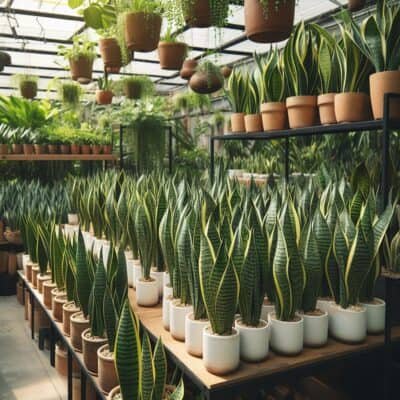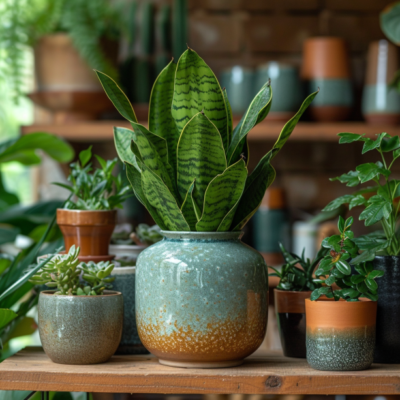“While snake plants may seem inexpensive, looks can be deceiving,” says interior designer Jane.
“Some rare varieties can cost hundreds or even thousands of dollars.”
But what makes certain snake plants so pricey?
This guide will walk you through the reasons behind the hefty price tags on fancy snake plant varieties.
We’ll explore factors like variegation, size, age, and demand that drive up costs.
You’ll also learn how to care for these prized houseplants to protect your investment.
Whether you’re a plant collector willing to splurge or just curious, this inside look at expensive snake plants will give you a new appreciation for these intriguing succulents.
KEY TAKEAWAY
Snake plant can be expensive, what to know?
While snake plants can be considered expensive, their premium quality, diverse varieties, and aesthetic appeal make them a worthwhile investment for those seeking sophisticated and luxurious home decor.
Why Snake Plants Can Cost a Pretty Penny
Snake plants are easy to care (1) for but not always cheap to buy!
While their low maintenance nature makes them perfect for folks short on green thumbs, demand and quality can really affect that price tag.
Let me walk you through some reasons those snake plants may cost more than you expect at the garden center.
Rare Beauties Aren’t so Easy to Find
Snake plants come in all sorts of cool varieties beyond your basic green. (2)
VARIEGATED plants with white or yellow stripes, or CRESTED specimens with wavy leaves, take extra work for growers to propagate.
Since they don’t multiply as quickly as plain green sansevierias, these unique breeds fetch a higher cost.
MATURE plants also demand top dollar since they provide an instant interiorscape instead of waiting years for the foliage to fill out.
Supply and Demand Determining Prices
Some snake plant varieties are simply trickier to mass produce than others.
If a type is slow-growing or difficult to cultivate in large batches, it will remain scarce.
Retailers know fewer options means higher prices shoppers will pay.
Seasonal demand spikes around holidays also jack up costs.
Remember Mother’s Day plant promotions? SNAKE PLANT LAURENTII became a hot item then.
When trends take off, preparation and quantities impact what we shell out.
Markups at Each Sales Point

A WHOLESALE grower like Costa Farms supplies big box stores at lower prices than what we see posted.
Then independent garden centers need to charge us consumers enough to cover THEIR expenses and profit too.
Consider the rent, materials, labor and other costs shop owners face.
Smaller specialty outfits also can’t buy in the huge bulk quantities of big retailers, making wholesale prices higher for them.
So that $20 sansevieria you spot could have started as little as $5 at the grow farm!
With these factors in mind, it makes sense why rarer or larger snake plants might leave us widening our eyes at the register.
But their hardy nature also means we’ll enjoy them for years to come without fussing over WATERING or FERTILIZING needs.
So while the price is high, our investment pays off in stress-free greenery indoors.
With their natural AIR PURIFYING perks too, snake plants may prove a better long-term value than cheaper short-lived blooms.
Just keep an eye out for sales to snag all but the most specialized varieties for less green.
Health Aspects of Snake Plants
Snake plants offer several health benefits that make them an excellent choice for any home or office.
Their ability to effectively remove toxins from the air through photosynthesis has been well-documented.
Studies show they can remove formaldehyde, benzene, and trichloroethylene – all common VOCs (VOLATILE ORGANIC COMPOUNDS) found indoors – from the air.
This makes SNAKE PLANTS a natural way to PURIFY indoor environments.
Their effectiveness is thanks to their broad, waxy leaves and slow growth rate.
This allows them to absorb pollutants efficiently over long periods without negative side effects.
It’s no surprise NASA included snake plants in their list of plants best for REMOVING indoor air toxins.
With formaldehyde and other petrochemical fumes emitted from building materials, cooking emissions, and other sources, their air PURIFYING powers provide a wellness boost indoors.
Beauty of Snake Plants
Beyond health perks, snake plants also offer an attractive look with low fuss.
Their stiff, upright foliage in hues of blue-gray to apple green make a lovely accent in any setting.
Simple green varieties have a classic, easy appeal.
But variegated cultivars featuring stripes of cream or yellow provide visual interest.
Crested cultivars with wavy, rumpled leaves introduce TEXTURAL appeal.
And some rarer gold or dark forms offer unexpected pops of color.
Their sculptural quality adds depth whether used as a TABLE CENTERPIECE or background filler.
Miniature varieties perfect for small spaces like patios, kitchens and BATHROOMS also give the illusion of a lush, tropical JUNGLE even in the smallest of areas.
Low light tolerance means snake plants thrive in NEARLY ANY SPOT without HIGH-INTENSITY sunlight.
Pair them with other foliages for low-maintenance, visual interest indoors with NO FUSSY watering demands like with other popular houseplants.
Their low-fuss nature gives constant greenery to any home or office with minimal disruption to busy schedules, making them a true crowd favorite.
How Much Do Snake Plants Typically Cost?

Whether you’re a gardening newbie or seasoned green thumb, pricing palm-sized snake plants affordably makes them a tempting pick.
Let’s break down typical cost expectations at your local indie shop or big box store.
Basic Varieties $10-30
Most COMMON sansevierias like LAURENTII, HAIfNII and CYLINDRICA stay reasonable.
Expect to pay $15-25 for a 4-6″ pot.
These DARK GREEN, drought TOLERANT varieties thrive with MINIMAL CARE.
Just water when the SOIL DRIES and keep in LOW, BRIGHT LIGHT.
Their EASY CARE nature means beginners need not fear.
Specialty Varieties $25 and Up
For something truly unique,variegated or showy sansevierias command higher quotes.
Their RARITY drives prices to $25-50 in the same small pot sizes.
Limited QUANTITIES produced and harder GROWING CONDITIONS factor in.
But fancier cultivars like FUTURA SUPERBA with hot PINK WINDOWS still prove wallet-friendly houseplants.
Large Specimens $50+
Well-ESTABLISHED plants over 1-2′ tall fetch top dollar, $50-150.
At this SIZE they serve as low fuss interior LANDSCAPING for offices or homes.
Popular AWARENESS and customer DEMAND for snake plants’ hardiness qualities contribute.
But large specimens please for YEARS with little WATER or fertilizer.
Factors influencing Costs
Besides type, rarity and size, RETAIL LOCATION and season also sway prices up or down.
Check for deals at big warehouse clubs.
Savvy Strategies for Budget-Friendly Snake Plants

Whether you’re starting a collection or seeking an affordable houseplant, these tricks will help you SAVE BIG on sansevierias.
- SHOP ONLINE AND BIG BOX RETAILERS for standbys like LAURENTII and HAIfNII. Websites offer deals throughout the year, while warehouse clubs keep basics reasonable daily.
- SCOUR LOCAL NURSERIES’ CLEARANCE AREAS. Seasonal markdowns or plant returns get reinvented here. I’ve found splendid 6″ pots half-off or more just from browsing discounted sections.
- PROPAGATE FROM YOUR OWN CLIPPINGS or swap cuttings with friends. Lay stems on soil to develop ROOTS for new plant starts at no added cost. Sansevierias’ pointed LEAVES root readily in WATER too.
- FOLLOW PLANTSTAGRAM HASHTAGS for sales alerts. Online retailers and indie shops often promote bundle deals or percent-off events exclusively on social media.
- CONSIDER MULTIPACK PURCHASES if growing your collection. Larger quantities offer better unit pricing that make adding more snake varieties to your indoor jungles more affordable overall.
Remember, sansevierias clean AIR and tolerate a WIDE RANGE of growing conditions indoors.
Their striking FOLIAGE in bold hues makes them ideal as lower-maintenance alternatives to pricier tropicals for any home or office.
With a little shopping creativity, inexpensive sansevierias become achievable houseplants for all green thumbs.
Growing Your Snake Plant Collection on a Budget
Sansevierias are one of the most affordable ways to start an indoor jungle. For those watching their spending, consider these tips proven to stretch your plant dollars.
- BEGIN WITH THE BASICS like LAURENTII varieties before upgrading. Their hardiness means even LIMITED NATURAL LIGHT homes can house snake plants.
- FOCUS ON FILLING DESIGNATED ROLES like a TABLE CENTERPIECE rather than impulse purchases. Let each plant EARN its place and prevent overcrowding.
- PROPAGATION provides almost endless potential to GROW YOUR COLLECTION at minimal cost. Learn to start BABY PLANTS from mature LEAVES or STEMS versus buying many small pots.
- CONSIDER TRADING with fellow local plant PARENTS rather than frequent shopping. Tap social media plant groups or gardening friends to exchange CUTTINGS you’ve struck root.
Care for your snake plants with diligence too.
DRAINAGE HOLES, POTTING SOIL and the occasional fertilizer provide everything they need to thrive indoors on a budget.
Your investments will CERTAINLY PURIFY THE AIR for years to come!
With some strategy and patience, even apartment gardeners or those new to houseplants can nurture a flourishing snake plant collection affordably.
Sansevieria Beauty Care

With minimal effort, uphold your snake plant’s striking beauty for years to come.
Some essential pointers:
Which Is Better For Snake Plant? Inside or Outside?
While sansevierias withstand OUTDOOR conditions, INSIDE ensures optimal bright, INDIRECT LIGHT without harsh sunburn risks.
Controlled temperatures, too, prevent stress.
Reserved backyards work, but INTERIORS suit their easygoing nature best.
Repotting
Check root growth annually in late winter/early spring.
Snugly TRANSPLANT into a POT with DRAINAGE HOLES just 1-2 inches wider using a loose, well-draining SOIL MIXTURE.
Regular dividing keeps mature specimens bushy.
Soil
AERATED, fast-draining POTTING SOIL encourages healthy roots.
Sansevierias thrive in soils similar to their arid native landscapes.
Add perlite or sand to conventional potting soil for extra DRAINAGE if needed.
Watering
Allow top couple inches of soil to completely DRY OUT between waterings while POTTING MIXTURE dries rather than stays CONSTANTLY MOIST.
Infrequent, deep drinks match their drought-tolerant character.
Monitor more closely in warmer months.
Follow these basics to keep your snake plant’s lush GREEN LEAVES flourishing indoors!
Type of Sansevieria
With so many unique cultivars, it’s easy to indulge your inner plant collector with these hardy perennials.
Here are some top contenders to consider:
Sansevieria Suffruticosa Variegated Suffruticosa.
Taking the classic suffruticosa up a notch, this cultivar has white and yellow stripes that add visual flair to any space.
The vertical stripes give these plants a stately, striped appearance whether used as single stalk centerpieces on tables or grouped together for low-light landscaping.
The bold variegation makes each leaf stand out and catches the eye.
Sansevieria Crested Hahnii
For collectors seeking a true oddity, hunt down the elusive crested hahniis.
Their wavy, rumpled leaves introduce one-of-a-kind texture unlike the straight foliage of other varieties.
Individual leaves are folded, rumpled and crested, giving the plant an overall textural presence that makes it a real showstopper even amongst more commonplace sansevieria.
These unusual specimens still stand out and impress among common varieties.
Sansevieria Regale
Reaching heights up to 3 feet tall, regales form statuesque upright columns thanks to their tall upright leaves paired with thick sturdy bases.
Their bold architectural presence and statuesque columnar habit dominate any landscape or space.
Proper staking shows them off to their full vertical effect.
Their tall rigid structure and vertical orientation give them a magnified sense of grandeur compared to lower, spreading varieties.
Frequently Asked Questions
Why are sansevieria trifasciata so expensive?
Snake plants known by their botanical name sansevieria trifasciata can cost more than other indoor plants because they are very hardy indoor plants that can survive low light conditions.
They are able to live for a long time with the right care making them a good investment as an indoor plant.
Are all snake plants expensive?
While some varieties like sansevieria trifasciata and sansevieria laurentii can be on the pricier side, there are also many affordable varieties of snake plants that do well as indoor plants.
Less common varieties like sansevieria futura superba tend to cost more, but hardier varieties like sansevieria zeylanica can often be found for reasonable prices.
Shopping around at different garden stores and greenhouses can help find the best deal.
Why does my snake plant have root rot?
Root rot is a common problem for snake plants kept in conditions that are too wet.
Snake plants prefer very dry conditions and only need water when the soil is completely dry.
Overwatering can cause the roots to rot.
Make sure there is good drainage in the nursery pot and plant indoors where it will not sit in water.
Check the roots and cut away any parts that are brown/soft.
Do snake plants need bright indirect light?
Snake plants are very tolerant of low light conditions and can grow in areas with very little natural lighting.
However, they will grow and produce new leaves faster if given at least some bright indirect light.
Near an east or west-facing window where they get partial sun for a few hours daily is ideal.
They can also do well under grow lights.
Too much direct sunlight for extended periods can actually burn the pointed leaves.
Is it ok to keep a snake plant in a ceramic pot?
A glazed ceramic pot works well for snake plants.
The glaze prevents water from evaporating too quickly which snake plants growing in dry conditions prefer.
Terra cotta or unglazed ceramic can cause the soil to dry out too fast.
It’s best to choose a nursery pot with drainage holes that fits inside the decorative ceramic pot.
This allows for watering without soggy soil conditions that can lead to root rot issues.
How often should I water my snake plant?
Most snake plants only need water when the top 1-2 inches of soil is completely dry.
Many homeowners underwater their snake plant because they are so tolerant of dry conditions.
As a general rule, water every 2-4 weeks during the growing season from spring to fall.
In the winter when plants are not actively growing, cut back watering to every 4-6 weeks or when the soil is very dry.
Overwatering is more hazardous than underwatering for snake plants.
How do I care for my mature snake plant?
Larger, more mature snake plants can still thrive indoors with the right care.
Make sure the plant is in a container with adequate drainage and good soil.
Use a well-draining potting mix.
Mature plants drink more than when small, so check the soil regularly and water when dry 1-2 inches deep.
Fertilize in the spring and summer with a dilute balanced houseplant fertilizer or plant food every few months.
Prune off any brown or dying leaves.
Rotate the pot weekly to encourage balanced growth.
Do snake plants clean the air?
It’s true that snake plants are effective at cleaning indoor air by removing toxins like formaldehyde, benzene and trichloroethylene.
Their wide, pointed leaves have indentations and pores that capture airborne pollutants.
Even NASA studies found that the snake plant, along with some other popular houseplants, were successful at removing dangerous chemicals from sealed chambers.
While not as efficient as an air purifier, snake plants can help naturally filter indoor air quality where people live and work.
How big do snake plants get?
Snake plants come in many varieties that vary in mature size.
Most common varieties top out somewhere between 2-4 feet tall but can get wider depending on pot size.
Some rarer varieties like sansevieria cylindrica may only reach 1 foot tall, while sansevieria kirkii and sansevieria masoniana can reach 6 feet tall given the right conditions.
Proper care and pot size will influence final height and spread.
Snake plants are generally slow growing but can get quite large over many years in ideal conditions with sufficient sunlight and nutrients.
Can I put my snake plant outside in the summer?
In mild summer climates, snake plants can be placed outside for the season to enjoy warmer temperatures and more natural lighting.
Some direct sunlight is fine for short periods, but snake plants do not want full sun for extended periods of time.
Provide afternoon shade or a spot with morning sun only.
Bring plants back inside before nighttime temperatures drop below 10°C (50°F) or if frost is predicted.
Outdoor plants will need more frequent watering than indoor plants.
Monitor for pests or signs of stress like yellowing leaves before the weather changes.
Conclusion
In the end, while basic snake plants are inexpensive, rare varieties can be quite pricy due to unique features like variegation, massive size, and age.
Supply and demand also impact costs.
Caring properly for these prized plants is key to protecting your investment.
With the right conditions, your rare snake plant can thrive for years.
We hope this guide gave you insight into the reasons behind costly snake plants.
Maybe you’re inspired to start your own rare plant collection.
Or you may just have a new appreciation for these intriguing succulents.
Whichever path you choose, use this knowledge to make informed choices when adding snake plants to your indoor jungle.
References
- https://en.wikipedia.org/wiki/Dracaena_trifasciata
- https://krishijagran.com/agripedia/list-of-rare-snake-plant-varieties-in-the-world/
Related Articles
- https://knowngarden.com/the-most-expensive-snake-plant-2021/
- https://knowngarden.com/unique-sansevieria-varieties-hard-to-find/
- https://knowngarden.com/how-much-light-does-a-snake-plant-need/



